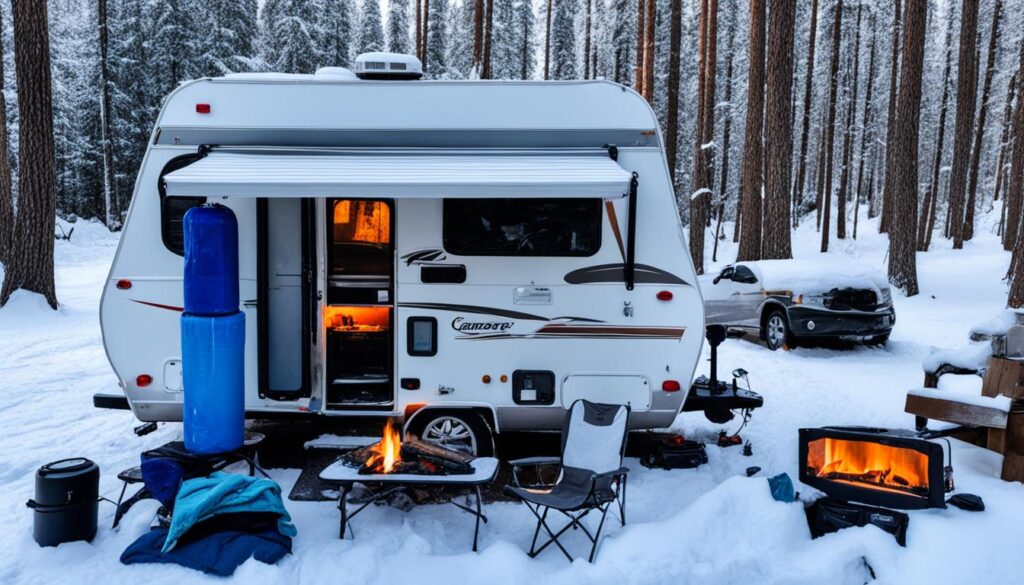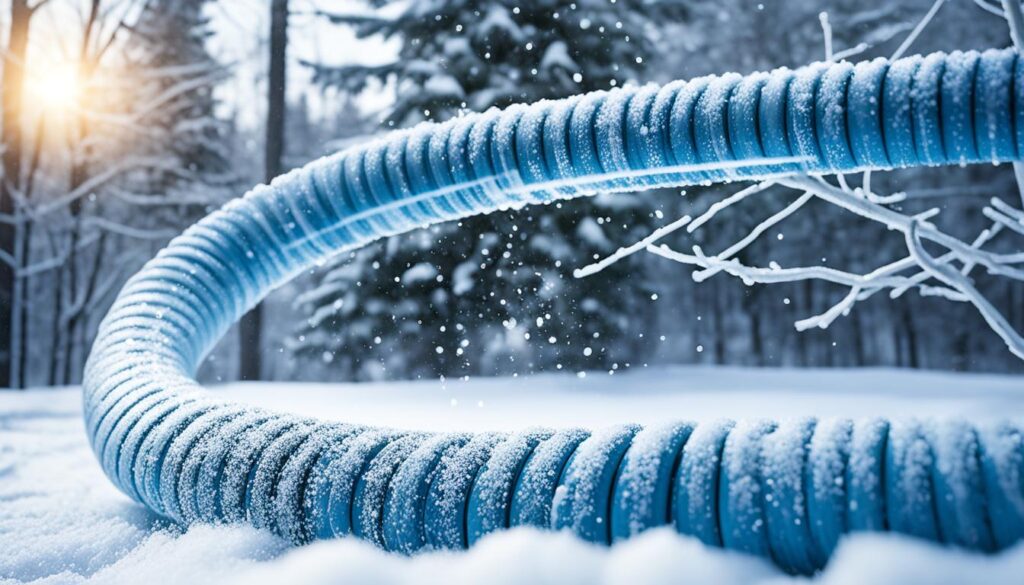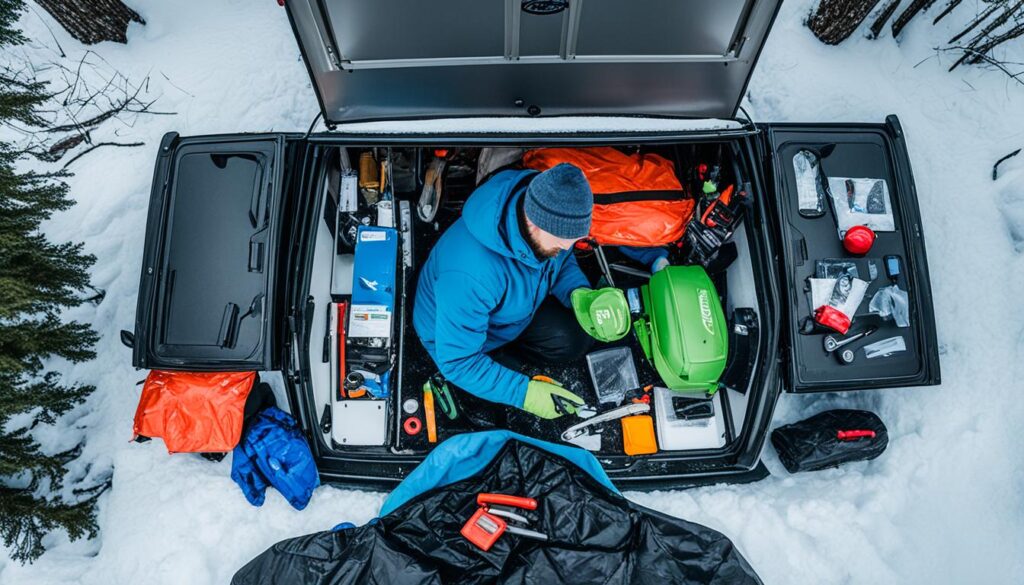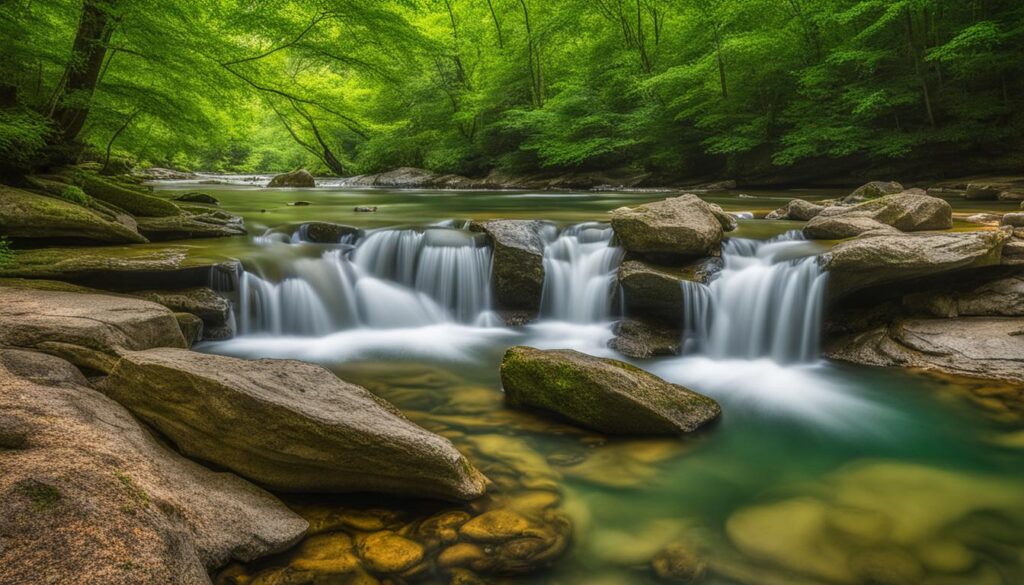Are you ready to face winter with your camper? As the temperature drops, it’s crucial to ensure that your beloved RV is properly protected from the cold. Winterizing your camper is not only about preventing damage but also about creating a cozy and comfortable living space during the chilly months. But where do you start? How do you make sure your camper is fully equipped to withstand the winter elements?
In this article, I will guide you through the essential steps of winterizing your camper. From preparing the exterior and interior to protecting the water supply and sewer system, I will provide you with a comprehensive checklist to ensure that your camper is ready for the cold months ahead. Say goodbye to frozen pipes, chilly nights, and unnecessary repairs. Get your camper winterization checklist ready and let’s dive in!
Key Takeaways:
- Winterizing your camper is crucial to protect it from freezing temperatures and ensure a comfortable living space.
- Preparing the exterior involves covering windows, doors, and skirting the RV to prevent cold air from seeping in.
- Cheap heat options like propane heaters and pellet stoves can help keep your RV warm without breaking the bank.
- Protecting the water supply and sewer system involves using heated hoses, insulation, and proper waste management.
- Keeping the interior warm requires strategic placement of space heaters, insulation of pipes, and using RV antifreeze.
Contents
Preparing the Exterior of Your RV for Winter
When it comes to winterizing your camper, one of the first steps is to prepare the exterior. Properly insulating and covering windows, doors, and the stairwell can help prevent cold air from seeping into your RV, ensuring a cozy and comfortable interior. There are various materials you can use for this purpose, including heavy fabric curtains, bubble wrap, or insulation boards. These options provide an extra layer of insulation and help maintain a warmer interior temperature.
Skirting your RV is another essential aspect of preparing its exterior for winter. This involves creating a barrier around the bottom of your RV to protect it from extreme cold. Skirting helps trap heat and prevents drafts from entering beneath the camper. If your RV does not have insulated bays, skirting is especially beneficial in maintaining a warmer interior. You can use a space heater under the coach or even pile up snow around the RV as a makeshift skirt. These measures not only add an extra layer of insulation but also contribute to the overall protection of your RV during winter.
By taking the necessary steps to prepare the exterior of your RV for winter, you can enhance its insulation and protect it from the harsh weather conditions. This will not only keep you comfortable during your winter camping trips but also extend the lifespan of your RV.
Cheap Heat Options for Winter RVing
When it comes to heating your RV inexpensively during winter, there are a few options to consider. One popular choice is a propane heater. Not only is it cost-effective, but it also consumes less propane compared to the furnace installed in your RV. However, it’s essential to exercise caution as propane heaters do not have an anti-tip shutoff and may produce carbon monoxide. Safety should always be a top priority.
Another option to warm up your RV quickly and efficiently is a pellet stove. This alternative utilizes a built-in fan to distribute heat evenly throughout your camper. Besides being more eco-friendly, pellet stoves can provide a cozy atmosphere during cold winter nights. However, it’s important to note that the installation and storage of a pellet stove may be more challenging compared to other heating options.
Both propane heaters and pellet stoves have their pros and cons, so it’s crucial to choose the option that best suits your needs and RV size. Take proper precautions and follow manufacturer instructions to ensure a safe and comfortable winter RVing experience.

Protecting Water Supply and Sewer System
The water supply and sewer system in your camper require extra protection during the winter months. Taking the necessary precautions can help prevent damage caused by freezing temperatures. Here are some essential steps to safeguard your water supply and sewer system:
Invest in a Heated Water Hose
One of the most effective ways to prevent freezing and bursting of water lines is by using a heated water hose. This specialized hose is designed to maintain a consistent temperature, ensuring a steady flow of water even in subzero conditions. Investing in a heated water hose is a wise choice to preserve the functionality of your water supply throughout the winter.

Insulate Exposed Pipes
Another crucial step in winterizing your water supply is insulating exposed pipes. Use pipe insulation or heat tape to provide an additional layer of protection. Wrap the insulation around the pipes, paying close attention to vulnerable areas such as exterior connections and fittings. This insulation will help retain heat and prevent pipes from freezing.
Cover the Water Connection to the RV
“By covering the water connection to the RV, you can further shield it from harsh winter conditions. Use a protective cover or insulated cap that fits securely over the connection. This will help prevent cold air from entering and potentially freezing the connection point.”
Choose a PVC Pipe for the Sewer System
When it comes to your sewer system, opt for a PVC pipe instead of a standard drain hose. PVC pipes provide better insulation against freezing temperatures. They are less likely to crack or become damaged, ensuring efficient waste removal during winter. Prioritize the durability and reliability of your sewer system by using a PVC pipe.
Maintain Proper Black Tank Management
To avoid blockages caused by frozen waste, it is recommended to keep the black tank closed off and only dump when necessary. This prevents excessive exposure to cold temperatures, reducing the risk of clogs and potential damage to the sewer system. Follow a regular dumping schedule that suits your needs and ensures optimal functionality throughout the winter.
By taking these measures to protect your water supply and sewer system, you can enjoy a worry-free winter camping experience. These precautions will help safeguard your camper’s essential amenities and prevent expensive repairs. Ensure a smooth and comfortable journey during the cold months ahead by prioritizing the winterization of your water and sewer systems.
Keeping the Interior of Your RV Warm
When it comes to winterizing your RV’s interior, there are a few key steps you can take to ensure a warm and cozy living space during the cold months. One practical option is to use space heaters strategically placed near the front and bedroom areas for optimal heating. These heaters provide an additional source of warmth, helping to maintain a comfortable temperature inside your RV.
An alternative to space heaters is investing in a heated mattress pad. This accessory not only provides added comfort while you sleep but also helps keep you warm during those chilly nights. By adjusting the heat settings to your preference, you can create a cozy environment that makes your RV feel like home.
In addition to using heating devices, proper insulation of pipes is crucial for winterizing your RV’s interior. This helps prevent freezing and potential damage to your water system. Using RV antifreeze in drains and the toilet is also essential to avoid any freezing issues. Remember to turn off the water heater and open faucets to release pressure, reducing the risk of damage due to freezing.
By following these interior winterization steps, you can create a comfortable and snug environment inside your RV throughout the winter season. Whether you choose to utilize space heaters or invest in a heated mattress pad, prioritizing the heating of your RV’s interior will ensure an enjoyable and cozy experience during your winter adventures.
FAQ
How do I winterize my camper?
To winterize your camper, you need to prepare the exterior and interior of the RV, cover windows and doors, skirt the RV, use cheap heat options, and insulate pipes. Following these steps will help protect your camper from the freezing temperatures.
How do I prepare the exterior of my RV for winter?
To prepare the exterior of your RV for winter, you should cover windows, doors, and the stairwell to prevent cold air from seeping in. You can use heavy fabric curtains, bubble wrap, or insulation boards for this purpose. Skirting your RV is also important to protect it from extreme cold. This can be done using a space heater under the coach or piling up snow around the RV.
What are some cheap heat options for winter RVing?
Some cheap heat options for winter RVing include using a propane heater or a pellet stove. A propane heater sips propane compared to the furnace installed in your RV but lacks an anti-tip shutoff and may produce carbon monoxide. On the other hand, a pellet stove can warm up your RV quickly and efficiently but may be challenging to install and store. Choose the option that best fits your needs and RV size.
How can I protect the water supply and sewer system in my camper during winter?
To protect the water supply and sewer system in your camper during winter, you can invest in a heated water hose to prevent freezing and bursting of water lines. Insulating exposed pipes and covering the water connection to the RV are also important. For the sewer system, using a PVC pipe instead of a standard drain hose can provide better protection against freezing temperatures. Keep the black tank closed off and only dump when necessary to avoid blockages caused by frozen waste.
How do I keep the interior of my RV warm during winter?
To keep the interior of your RV warm during winter, you can use space heaters strategically placed near the front and bedroom areas for optimal heating. Investing in a heated mattress pad can also provide additional warmth during cold nights. Properly insulating pipes and using RV antifreeze in drains and the toilet are essential to prevent freezing. Don’t forget to turn off the water heater and open faucets to release pressure.






